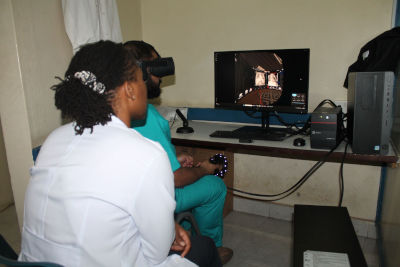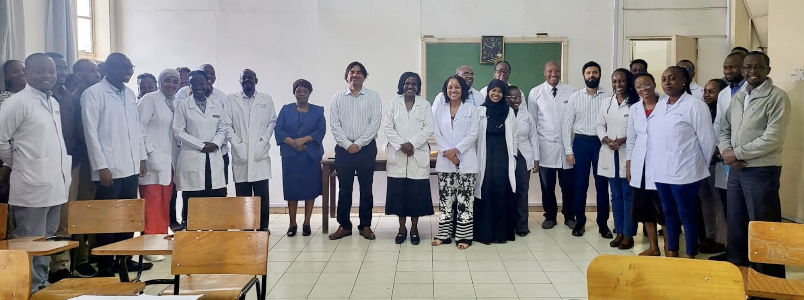The Department of Radiology’s global health program is breaking new ground in Kenya, including an educational exchange, a visiting professorship, and the pioneering of a new virtual reality teaching program.
They say a picture is worth a thousand words and that’s especially true in the world of radiology. But the images can only speak when a professional reads them with expert analysis to help diagnose and treat patients. This knowledge comes from years of education and training and by embracing technological advances to further see inside patients to better understand their condition, prognosis, and treatment options.
A novel partnership between Queen’s University and University of Nairobi, Kenya is creating a new image for global health education.
In 2019, the Department of Radiology with the University of Nairobi to help educate and mentor radiology residents and build capacity in medical education and professional development. It started with the basics: installing better IT equipment and ensuring a more robust Internet connection and bandwidth to facilitate online education and collaboration. From there, the program moved into an online educational exchange and has grown to add a visiting professorship, scholarship opportunities, and a new virtual reality (VR) component to classroom teaching.
“In Africa, most of the radiology programs are still immature and the ratio of learners to teachers is quite high with limited time in the classroom,” says Dr. Omar Islam, Department Head and Assistant Professor, Department of Diagnostic Radiology. “COVID highlighted some of the big disparities in health systems around the globe in terms of vaccines and social determinants of health, but when we looked more deeply, we saw there was a discrepancy at the physician training and health education level in residency programs. We saw this as an excellent opportunity to help bridge that gap, while also recognizing that there are things we can learn from each other.”
Bringing virtual reality to education

Students at the University of Nairobi using the VR goggles
This past fall, a new innovation was introduced to the teaching program using VR technology that connects Queen’s faculty in Kingston with resident learners at the Nairobi hospital—the first program of its kind in the world, according to Dr. Islam. The VR headsets are worn by both students and teachers and allows for a richer, in-depth educational experience to give students a better opportunity to engage with the teacher and with the images they are studying. For participants, the experience is more dynamic than a Zoom lecture and similar to being in the same room together with more interaction.
“We find the students are participating more, they’re asking more questions, pointing and zooming in to the images to ask if we see what they see. It feels like we are with the students in person. It’s completely changed our teaching program,” says Dr. Denise Castro, Assistant Professor and Global Health Lead for the department.
“It was exciting to put them on and find yourself in a different room, where the images are large, and you can scroll through them. It was almost an out-of-body experience on my part,” says Dr. Gladys Mwango, a senior lecturer and former chair of the Department of Diagnostic Imaging and Radiation Medicine at the University of Nairobi who helped start the partnership with Dr. Islam four years ago. To engage more students in the learning activity, some of the views inside the goggles can be projected on a large screen to the rest of the class. “It’s awesome. I found it really exciting and offers a very different experience that is more interactive,” says Ruth Mulwa, the outgoing chief resident who was a student in a number of VR-led sessions.
The VR goggles come from Luxsonic, a company based out of Saskatoon, which trained users in Kingston and Nairobi on site prior to classes starting last September. Two headsets were purchased for $36,000 with the help of the Kingston Rotary Club and a grant from the Department of Diagnostic Radiology Academic Fund, and they are actively seeking ways to add additional headsets to help grow the program. Dr. Islam and his team are currently engaged in a research project funded by an to evaluate the educational exchange program and will conduct a similar four-year educational research project for the VR goggles initiative.
The Department of Radiology at Queen’s has a long history of innovation. In fact, some of the first x-rays in Canada were taken at Kingston General Hospital just two months after x-rays were introduced to the world by inventor Wilhelm Conrad Röentgen in Germany.
Building relationships through education and collaboration

Dr. Omar Islam (centre, white striped shirt) with faculty and students from the Department of Diagnostic Imaging and Radiation Medicine at the University of Nairobi
The team in Nairobi are very much a part of the Queen’s faculty and the partnership has created bi-directional learning opportunities. Faculty from Nairobi are included in Grand Rounds for the department and present regularly, sharing information about cases involving conditions and diseases that are not as prevalent in Canada. “There is a very large population in Kenya with chronic liver disease, cirrhosis, hepatic cancers, and tropical diseases that we don’t see as often. So, this is an opportunity to enrich our own learning as much as we are helping them,” adds Dr. Islam.
Dr. Islam visited Nairobi in the fall as the inaugural visiting professor in Radiology’s global health program and will be sending another professor there annually to build on the relationship. The collaboration includes teaching, and growing capacity to support and deliver evaluations, exams, and assessments. Radiology exams in Kenya are still university-based. Developing radiology- board-based exams to bring more evaluation expertise to the partnership would be another step forward.
“This is our first foray into global health as a department. We have taken it slow, but it has matured and has been really rewarding,” says Dr. Islam, adding that the overall goal is to build a long-lasting bond that will allow for further mentorship as residents build their careers, years after their time in the classroom.
“There are diseases that can sometimes be diagnosed with just a simple x-ray or ultrasound and they may not have the equipment or knowledge that we have here to do that. Or, they may have the images, but not someone to read it. So, it’s important we transfer these skills and knowledge so they can improve the radiology education and overall level of health care for patients,” says Dr. Castro.